

This article is an excerpt from the Shortform book guide to "Onward" by Howard Schultz. Shortform has the world's best summaries and analyses of books you should be reading.
Like this article? Sign up for a free trial here.
What is Howard Schultz like as a leader? How did Schultz help Starbucks out of a rut?
In 2008, Howard Schultz made his official return to Starbucks. In his first few months as CEO, he used two strategies to project a reassuring image to both internal and external stakeholders: strong communication and timely action.
Let’s look at these two elements of Howard Schultz’s leadership style.
Strong Communication
Howard Schultz’s leadership style is best represented by his triumph return to Starbucks. Schultz says that when he considered how to announce his return as CEO, he knew it would be important to communicate a reassuring message. He wanted stakeholders to understand that he was devoted to improving the company’s health and that they could trust him to accomplish that. If they didn’t trust him, employees might perform poorly at work, customers might lose interest in the company’s products, and investors might pull out and decrease the company’s value.
(Shortform note: In The Speed of Trust, leadership consultant Stephen M.R. Covey explains why trust is so instrumental to a company’s health. Covey says that in business contexts, trust magnifies the results of your efforts—which means you don’t have to work as hard to accomplish your goals. To illustrate, if Schultz had failed to gain customers’ trust when he became CEO, he would have had to put more time, effort, and money into getting them to buy Starbucks coffee. To prove the value of instilling trust in your leadership, Covey points to data showing that companies in which employees trust one another outperform companies with low levels of trust by significant margins.)
To project a reassuring image, Schultz strove to communicate transparently about his resumption of the CEO role. In both internal and external messages, he accepted responsibility for the company’s current failures and stated his intention to correct Starbucks’ course. He shared three turnaround strategies in every message: overhauling the company’s management, improving its financial standing, and enhancing its coffeehouse experience. (We’ll discuss each of these in more detail later in the guide.)
(Shortform note: Covey’s description of trust-building practices in The Speed of Trust explains how transparent communication helped Schultz reassure stakeholders. Covey says you can earn trust by demonstrating authenticity and humility and by clarifying what others can expect from you. Schultz demonstrated authenticity by speaking frankly about an uncomfortable situation (Starbucks’ poor performance), and he demonstrated humility by taking responsibility for Starbucks’ mistakes. In communicating his three turnaround strategies, Schultz also clarified what others could expect from him, setting himself up to be accountable for Starbucks’ future.)
Schultz also quickly opened up communication with in-store employees to gain clearer insight into the problems and successes they were experiencing. He invited them to email him directly and made it a priority to respond to their emails, often with a phone call. He also began holding quarterly Partner Open Forums where leadership and employees could openly discuss any relevant issues they wanted. Finally, he started sending regular emails to all Starbucks employees, giving them insight into his ideas for the direction Starbucks would take going forward.
(Shortform note: Opening up communication with employees helped Schultz gain their trust and improved their engagement. As Jack Canfield explains in The Success Principles, encouraging employees to give feedback proves that you value them and allows them to actively participate in improving their workplaces. Similarly, in No Rules Rules, Netflix CEO Reed Hastings says that organizational transparency—achieved by clear, open internal communication—increases employees’ sense of ownership and responsibility for the company, which inspires them to put more effort into their work and help the company succeed.)
Timely Action
Schultz’s other strategy for reassuring stakeholders of his leadership acumen was to begin implementing changes right away. With the help of his support staff and a consulting company, he immediately started thinking of specific strategies that would help Starbucks turn its performance around and making changes that aligned with the turnaround strategies we highlighted earlier. Schultz and his team also organized a conference to inspire Starbucks executives to think critically about what made Starbucks uniquely valuable and culturally important.
(Shortform note: How did taking timely action help reassure stakeholders? One explanation could be that it demonstrated Schultz’s competency. In The Speed of Trust, Covey explains that people are more likely to trust you if they believe in your abilities; the best way to earn that trust is by delivering the results you’ve promised. By delivering results expeditiously, Schultz gave stakeholders proof that they could put their faith in him. This may also explain why one of Schultz’s first moves as CEO was to organize a conference for executives: It was important for all of Starbucks’ leaders to demonstrate their competence—or become more competent, if necessary, by reinforcing their understanding of core company values.)
To prove to stakeholders that monumental changes were underway, Schultz made a bold decision: He tackled one of Starbucks’ most pressing issues—employee underperformance—by closing every US store for an afternoon to retrain employees on how to make a proper espresso drink. (Shortform note: Starbucks reused this strategy following a 2018 racial bias incident that occurred when a store manager had two Black men arrested for asking to use the bathroom. Video of the arrest went viral and resulted in widespread scrutiny, which prompted the company to close all US stores so employees could undergo racial bias training.)
Schultz explains that customers were complaining Starbucks baristas were uninspired and poorly trained. Espresso drinks are finicky (even pouring speed affects their flavor), so it was integral for every employee to know the right technique and understand the importance of good customer service for Starbucks’ survival. The company lost money on this training, but Schultz felt it was worthwhile because it would restore customers’ trust and reassure investors that things were looking up.
| Schultz Balanced Extreme Actions With Clear Thinking Schultz explains that it was risky to close all Starbucks stores for retraining, but he believed the move would pay off by improving stakeholders’ faith in Starbucks. Let’s explore how Schultz balanced two seemingly contradictory leadership maxims—extreme action and clear thinking—as he made this decision. In The 10X Rule, entrepreneur Grant Cardone explains that taking “extreme action” means taking unreasonable steps toward your goal—steps few others would consider taking. Cardone believes that taking extreme action guarantees success because if you only take average action, or if you refuse to act or wait too long, you lose out on valuable opportunities to improve your situation. However, in The Art of Thinking Clearly, entrepreneur Rolf Dobelli argues that it’s easy for decision-makers to fall victim to the logical fallacy known as action bias—the human tendency to act too quickly for fear of a missed opportunity. According to this perspective, it’s better to pause before you act and consider your options carefully, lest you make a rash decision with poor outcomes. Although Schultz’s choice to close all stores for retraining was extreme and carried out quickly, it wasn’t rushed or poorly informed. He balanced his tendency to act quickly with clear forethought and rationality, basing his decision on data (like customer complaints) and strategy (his understanding of the relationship between customer satisfaction and corporate success). Achieving this balance helped Schultz determine the proper course of action. |

———End of Preview———
Like what you just read? Read the rest of the world's best book summary and analysis of Howard Schultz's "Onward" at Shortform.
Here's what you'll find in our full Onward summary:
- Why Starbucks CEO Howard Schultz left and later returned to the company
- Schultz’s three-part strategy that saved Starbucks from potential ruin
- Why millions of people love Starbucks’ coffeehouse experience






